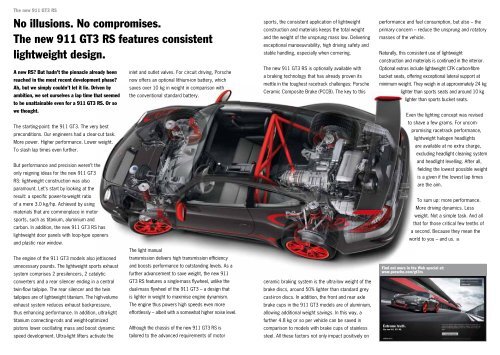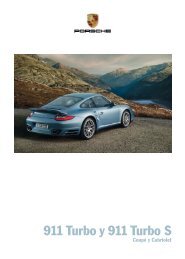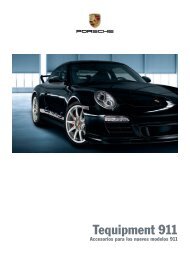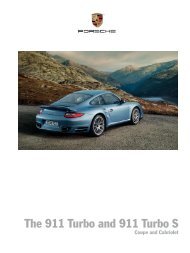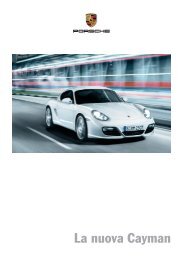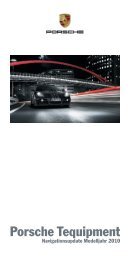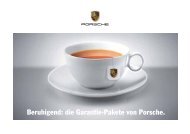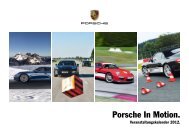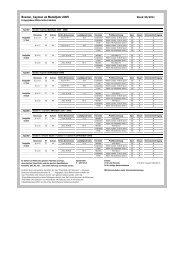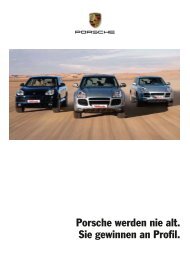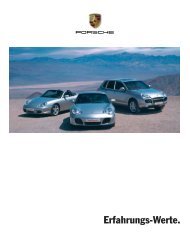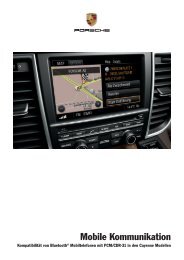Porschenews 04/2009 Unleashed. The new Boxster Spyder.
Porschenews 04/2009 Unleashed. The new Boxster Spyder.
Porschenews 04/2009 Unleashed. The new Boxster Spyder.
Create successful ePaper yourself
Turn your PDF publications into a flip-book with our unique Google optimized e-Paper software.
<strong>The</strong> <strong>new</strong> 911 GT3 RS<br />
No illusions. No compromises.<br />
<strong>The</strong> <strong>new</strong> 911 GT3 RS features consistent<br />
lightweight design.<br />
A <strong>new</strong> RS? But hadn’t the pinnacle already been<br />
reached in the most recent development phase?<br />
Ah, but we simply couldn’t let it lie. Driven by<br />
ambition, we set ourselves a lap time that seemed<br />
to be unattainable even for a 911 GT3 RS. Or so<br />
we thought.<br />
<strong>The</strong> starting-point: the 911 GT3. <strong>The</strong> very best<br />
preconditions. Our engineers had a clear-cut task.<br />
More power. Higher performance. Lower weight.<br />
To slash lap times even further.<br />
But performance and precision weren’t the<br />
only reigning ideas for the <strong>new</strong> 911 GT3<br />
RS: lightweight construction was also<br />
paramount. Let’s start by looking at the<br />
result: a specific power-to-weight ratio<br />
of a mere 3.0 kg/hp. Achieved by using<br />
materials that are commonplace in motor<br />
sports, such as titanium, aluminium and<br />
carbon. In addition, the <strong>new</strong> 911 GT3 RS has<br />
lightweight door panels with loop-type openers<br />
and plastic rear window.<br />
<strong>The</strong> engine of the 911 GT3 models also jettisoned<br />
unnecessary pounds. <strong>The</strong> lightweight sports exhaust<br />
system comprises 2 presilencers, 2 catalytic<br />
converters and a rear silencer ending in a central<br />
twin-flow tailpipe. <strong>The</strong> rear silencer and the twin<br />
tailpipes are of lightweight titanium. <strong>The</strong> high-volume<br />
exhaust system reduces exhaust backpressure,<br />
thus enhancing performance. In addition, ultra-light<br />
titanium connecting-rods and weight-optimized<br />
pistons lower oscillating mass and boost dynamic<br />
speed development. Ultra-light lifters activate the<br />
inlet and outlet valves. For circuit driving, Porsche<br />
now offers an optional lithium-ion battery, which<br />
saves over 10 kg in weight in comparison with<br />
the conventional standard battery.<br />
<strong>The</strong> light manual<br />
transmission delivers high transmission efficiency<br />
and boosts performance to outstanding levels. As a<br />
further advancement to save weight, the <strong>new</strong> 911<br />
GT3 RS features a single-mass flywheel, unlike the<br />
dual-mass flywheel of the 911 GT3 – a design that<br />
is lighter in weight to maximise engine dynamism.<br />
<strong>The</strong> engine thus powers high speeds even more<br />
effortlessly – albeit with a somewhat higher noise level.<br />
Although the chassis of the <strong>new</strong> 911 GT3 RS is<br />
tailored to the advanced requirements of motor<br />
sports, the consistent application of lightweight<br />
construction and materials keeps the total weight<br />
and the weight of the unsprung mass low. Delivering<br />
exceptional manoeuvrability, high driving safety and<br />
stable handling, especially when cornering.<br />
<strong>The</strong> <strong>new</strong> 911 GT3 RS is optionally available with<br />
a braking technology that has already proven its<br />
mettle in the toughest racetrack challenges: Porsche<br />
Ceramic Composite Brake (PCCB). <strong>The</strong> key to this<br />
ceramic braking system is the ultra-low weight of the<br />
brake discs, around 50% lighter than standard grey<br />
cast-iron discs. In addition, the front and rear axle<br />
brake cups in the 911 GT3 models are of aluminium,<br />
allowing additional weight savings. In this way, a<br />
further 4.8 kg or so per vehicle can be saved in<br />
comparison to models with brake cups of stainless<br />
steel. All these factors not only impact positively on<br />
performance and fuel consumption, but also – the<br />
primary concern – reduce the unsprung and rotatory<br />
masses of the vehicle.<br />
Naturally, this consistent use of lightweight<br />
construction and materials is continued in the interior.<br />
Optional extras include lightweight CFK carbon-fibre<br />
bucket seats, offering exceptional lateral support at<br />
minimum weight. <strong>The</strong>y weigh in at approximately 24 kg<br />
lighter than sports seats and around 10 kg<br />
lighter than sports bucket seats.<br />
Even the lighting concept was revised<br />
to shave a few grams. For uncompromising<br />
racetrack performance,<br />
lightweight halogen headlights<br />
are available at no extra charge,<br />
excluding headlight cleaning system<br />
and headlight levelling. After all,<br />
fielding the lowest possible weight<br />
is a given if the lowest lap times<br />
are the aim.<br />
To sum up: more performance.<br />
More driving dynamics. Less<br />
weight. Not a simple task. And all<br />
that for those critical few tenths of<br />
a second. Because they mean the<br />
world to you – and us.<br />
Find out more in the Web special at:<br />
www.porsche.com/gt3rs


